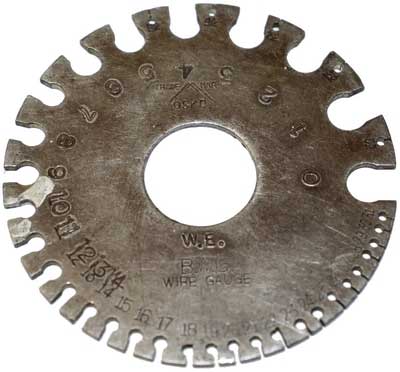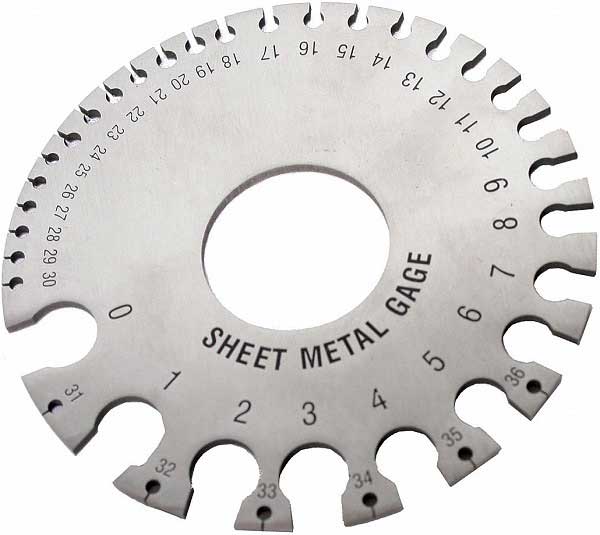 |
BWG - Birmingham Wire Gauge |
The Birmingham gauge is a wire gauge system, and is also used to specify thickness or diameter of hypodermic/injection needles and tube products. Birmingham gauge is also known as the Stubs Iron Wire Gauge.
The BWG gauge starts at the lowest gauge number of 5/0 or 00000, corresponding to the largest size of 0.500 inch (12.7mm) to the highest gauge number of 36, corresponding to the smallest size of 0.004 inch (0.102mm). Size steps between gauges range from 0.001 inch between high gauge numbers to 0.046 inch between the two lowest gauge numbers and do not correspond to a particular mathematical pattern, although for the most part the steps get smaller with increasing gauge number.
Concerning wire and fine tubing, the gauge number is used to specify the outside diameter of the product, whereas for larger mechanical tubing the gauge number specifies the wall thickness independent of the overall size of the tube.
In medicine, the Birmingham gauge specifies the outside diameter of hypodermic/injection needles, catheters, cannulae and suture wires. It was originally developed in early 19th-century England for use in wire manufacture, and it began appearing in a medical setting in the early 20th century.
The imperial and metric conversions for Birmingham wire gauge measurements are presented in the table below.
| Gauge | BWG inches |
BWG mm |
| (5/0) | 0.500 | 12.7 |
| (4/0) | 0.454 | 11.532 |
| (3/0) | 0.425 | 10.795 |
| (2/0) | 0.380 | 9.652 |
| 0 | 0.340 | 8.636 |
| 1 | 0.300 | 7.62 |
| 2 | 0.284 | 7.213 |
| 3 | 0.259 | 6.579 |
| 4 | 0.238 | 6.045 |
| 5 | 0.220 | 5.588 |
| 6 | 0.203 | 5.156 |
| 7 | 0.180 | 4.572 |
| 8 | 0.165 | 4.191 |
| 9 | 0.148 | 3.759 |
| 10 | 0.134 | 3.404 |
| 11 | 0.120 | 3.048 |
| 12 | 0.109 | 2.769 |
| 13 | 0.095 | 2.413 |
| 14 | 0.083 | 2.108 |
| 15 | 0.072 | 1.829 |
| 16 | 0.065 | 1.651 |
| 17 | 0.058 | 1.473 |
| 18 | 0.049 | 1.245 |
| 19 | 0.042 | 1.067 |
| 20 | 0.035 | 0.888 |
| 21 | 0.032 | 0.813 |
| 22 | 0.028 | 0.711 |
| 23 | 0.025 | 0.635 |
| 24 | 0.022 | 0.559 |
| 25 | 0.020 | 0.508 |
| 26 | 0.018 | 0.457 |
| 27 | 0.016 | 0.406 |
| 28 | 0.014 | 0.356 |
| 29 | 0.013 | 0.330 |
| 30 | 0.012 | 0.305 |
| 31 | 0.010 | 0.254 |
| 32 | 0.009 | 0.229 |
| 33 | 0.008 | 0.203 |
| 34 | 0.007 | 0.178 |
| 35 | 0.005 | 0.127 |
| 36 | 0.004 | 0.102 |

Remark(s) of the Author...
Recently, I was involved in heat exchanger inspection, by Eddy Current.
Most companies have a partner (third party) to do the special inspection. For the third party, it is important to know the outside diameter, the wall thickness, the number and the lengths of the tubes. OD minus 2 times the wall thickness is the Inside Diameter (ID), and so the third party knows which sensor to use. Of course, the length of the tubes is also important for the length of the sensor.
In one of the bundle tube specifications, the wall thickness was indicated by BWG14.
At first I didn't know what it meant.
That is easy to explain, because all dimensions of other bundle exchangers were given in inches and millimeters, but not in Birmingham Wire Gauges.
So BWG14 (in the table above) tells us that the wall thickness of the bundle tubes is 0.083 inches or 2,108 mm.
Every day I learn something new, and I hope the same applies to you.
Related Post(s)

When working with sheet metal, the term "gauge or gage" is often used, and is used to indicate the thickness of a metal sheet...